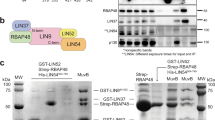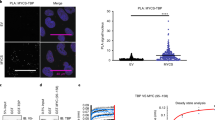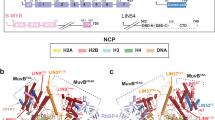Abstract
Sin3A or Sin3B are components of a corepressor complex that mediates repression by transcription factors such as the helix-loop-helix proteins Mad and Mxi. Members of the Mad/Mxi family of repressors play important roles in the transition between proliferation and differentiation by down-regulating the expression of genes that are activated by the proto-oncogene product Myc. Here, we report the solution structure of the second paired amphipathic helix (PAH) domain (PAH2) of Sin3B in complex with a peptide comprising the N-terminal region of Mad1. This complex exhibits a novel interaction fold for which we propose the name 'wedged helical bundle'. Four α-helices of PAH2 form a hydrophobic cleft that accommodates an amphipathic Mad1 α-helix. Our data further show that, upon binding Mad1, secondary structure elements of PAH2 are stabilized. The PAH2–Mad1 structure provides the basis for determining the principles of protein interaction and selectivity involving PAH domains.
This is a preview of subscription content, access via your institution
Access options
Subscribe to this journal
Receive 12 print issues and online access
$189.00 per year
only $15.75 per issue
Buy this article
- Purchase on Springer Link
- Instant access to full article PDF
Prices may be subject to local taxes which are calculated during checkout




Similar content being viewed by others
Accession codes
References
Schreiber-Agus, N. & DePinho, R.A. Bioessays 20, 808–818 (1998).
Foley, K.P. & Eisenman, R.N. Biochim. Biophys. Acta 1423, M37–M47 ( 1999).
Xu L., Glass, C.K. & Rosenfeld, M.G. Curr. Opin. Genet. Dev. 9, 140–147 (1999).
Heinzel, T. et al. Nature 387, 43–48 (1997).
Alland, L. et al. Nature 387, 49–55 (1997).
Hassig, C.A., Fleischer, T.C., Billin, A.N., Schreiber, S.L. & Ayer, D.E. Cell 89, 341–347 (1997).
Laherty, C.D. et al. Cell 89, 349–356 (1997).
Zhang, Y., Iratni, R., Erdjument-Bromage, H., Tempst, P. & Reinberg, D. Cell 89, 357–364 (1997).
Nagy, L. et al. Cell 89, 373–380 (1997).
Ayer D.E., Lawrence, Q.A. & Eisenman, R.N. Cell 80, 767– 776 (1995).
Schreiber-Agus, N. et al. Cell 80, 777–786 (1995).
Eilers, A.L., Billin, A.N., Liu, J. & Ayer, D.E. J. Biol. Chem. 274, 32750–32756 ( 1999).
Laherty, C.D. et al. Mol. Cell 2, 33–42 (1998).
Sheinerman, F.B., Norel, R. & Honig, B. Curr. Opin. Struct. Biol. 10, 153–159 (2000).
Wishart, D.S. & Sykes, B.D. J. Biomol. NMR 4, 171–180 (1994).
Dignam, J.D., Lebovitz, R.M. & Roeder, R.G. Nucleic Acids Res. 11, 1475 –1489 (1983)
Delaglio, F. et al. J. Biomol. NMR 6, 277– 293 (1995).
Brunger A.T. et al. Acta Crystallogr. D 54, 905– 921 (1998).
Nilges, M., Macias, M.J., O'Donoghue, S.I. & Oschkinat, H. J. Mol. Biol. 269, 408–422 (1997).
Koradi, R., Billeter, M. & Wüthrich, K. J. Mol. Graph. 14, 51– 55 (1996).
Vriend, G. J. Mol. Graph. 52, 29–36 (1990).
Laskowski, R.A., Rullmann, J.A., MacArthur, M.W., Kaptein, R. & Thornton, J.M. J. Biomol. NMR 8, 477–486 ( 1996).
Acknowledgements
We thank J. Aelen for technical assistance and purification of the labeled proteins. We wish to thank the members of our Departments and J. Betz for suggestions and critical reading of the manuscript. We thank B. Eisenman for his generous gift of the mSin3 cDNAs, D. Reinberg for Sap30 antibody, and A. Gronenborn for the pGev2 construct. The research of C. Spronk and M. Vermeulen is financially supported by the Netherlands Organization for Scientific Research (NWO).
Author information
Authors and Affiliations
Corresponding author
Rights and permissions
About this article
Cite this article
Spronk, C., Tessari, M., Kaan, A. et al. The Mad1–Sin3B interaction involves a novel helical fold. Nat Struct Mol Biol 7, 1100–1104 (2000). https://doi.org/10.1038/81944
Received:
Accepted:
Issue Date:
DOI: https://doi.org/10.1038/81944
This article is cited by
-
Newly identified Gon4l/Udu-interacting proteins implicate novel functions
Scientific Reports (2020)
-
Sin3A recruits Tet1 to the PAH1 domain via a highly conserved Sin3-Interaction Domain
Scientific Reports (2018)
-
Myt1l safeguards neuronal identity by actively repressing many non-neuronal fates
Nature (2017)
-
Sin3 interacts with Foxk1 and regulates myogenic progenitors
Molecular and Cellular Biochemistry (2012)
-
Pleiotropic corepressors Sin3 and Ssn6 interact with repressor Opi1 and negatively regulate transcription of genes required for phospholipid biosynthesis in the yeast Saccharomyces cerevisiae
Molecular Genetics and Genomics (2011)



